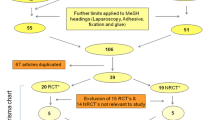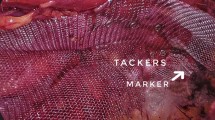Abstract
Background
Glue mesh fixation is thought to cause less pain compared to tack mesh fixation during laparoscopic total extraperitoneal inguinal hernia repair (TEP). However, the clinical benefits of glue mesh fixation are still controversial. This study aimed to evaluate the acute pain, chronic pain, and recurrence rate between these two fixation methods.
Methods
After reviewing all patients in our prospective hernia repair database from February 2008 to December 2017, we identified 583 patients who underwent TEP with tack mesh fixation and 70 patients with glue fixation by a single surgeon. Acute post-operative pain and activity level were evaluated using a Visual Analog Score (VAS) and the modified Medical Outcome Study (MOS) score. The primary endpoint was chronic pain 6 months after TEP. The secondary endpoints were acute pain, activity level, complications, and recurrence.
Results
After adjustment for potential confounding factors, the glue mesh fixation had significant lower VAS at 2 h post operation during rest and coughing and on the first day after surgery during coughing (p = 0.005, p < 0.001, and p = 0.011). The modified MOS on the first day was higher in the glue group (p < 0.001). There were no reduced risk of chronic pain or increased risk of recurrence for the glue group compared to the tack group [Odds ratio (OR) = 0.237, p = 0.169; OR = 2.498, p = 0.299]. In the sub-group analysis for recurrent hernia repair, glue fixation is associated with better modified MOS (p = 0.031) on first day and lower VAS on the operative day and first day at rest (p = 0.003 and p = 0.024) after surgery.
Conclusions
Glue fixation method was superior to tack fixation method in acute post-operative pain and early post-operative activity level after laparoscopic TEP repair. However, both fixation methods had similar incidence of chronic pain-, recurrence-, and procedure-related complications after laparoscopic TEP repair.

Similar content being viewed by others
References
Langeveld HR, van’t Riet M, Weidema WF, Stassen LP, Steyerberg EW, Lange J, Bonjer HJ, Jeekel J (2010) Total extraperitoneal inguinal hernia repair compared with Lichtenstein (the LEVEL-Trial): a randomized controlled trial. Ann Surg 251:819–824
Schmedt CG, Sauerland S, Bittner R (2005) Comparison of endoscopic procedures vs Lichtenstein and other open mesh techniques for inguinal hernia repair: a meta-analysis of randomized controlled trials. Surg Endosc 19:188–199
Aasvang EK, Mohl B, Bay-Nielsen M, Kehlet H (2006) Pain related sexual dysfunction after inguinal herniorrhaphy. Pain 122:258–263
Niebuhr H, Wegner F, Hukauf M, Lechner M, Fortelny R, Bittner R, Schug-Pass C, Kockerling F (2018) What are the influencing factors for chronic pain following TAPP inguinal hernia repair: an analysis of 20,004 patients from the Herniamed Registry. Surg Endosc 32:1971–1983
Wong JU, Leung TH, Huang CC, Huang CS (2011) Comparing chronic pain between fibrin sealant and suture fixation for bilayer polypropylene mesh inguinal hernioplasty: a randomized clinical trial. Am J Surg 202:34–38
Antoniou SA, Kohler G, Antoniou GA, Muysoms FE, Pointner R, Granderath FA (2016) Meta-analysis of randomized trials comparing nonpenetrating vs mechanical mesh fixation in laparoscopic inguinal hernia repair. Am J Surg 211:239–249.e232
Gutlic N, Rogmark P, Nordin P, Petersson U, Montgomery A (2016) Impact of mesh fixation on chronic pain in total extraperitoneal inguinal hernia repair (TEP): a nationwide register-based study. Ann Surg 263:1199–1206
Chung SD, Huang CY, Chueh SC, Tsai YC, Yu HJ (2011) Feasibility and safety of total extraperitoneal inguinal hernia repair after previous lower abdominal surgery: a case-control study. Surg Endosc 25:3353–3356
Chung SD, Huang CY, Wang SM, Hung SF, Tsai YC, Chueh SC, Yu HJ (2011) Laparoendoscopic single-site totally extraperitoneal adult inguinal hernia repair: initial 100 patients. Surg Endosc 25:3579–3583
Tsai YC, Ho CH, Tai HC, Chung SD, Chueh SC (2013) Laparoendoscopic single-site versus conventional laparoscopic total extraperitoneal hernia repair: a prospective randomized clinical trial. Surg Endosc 27:4684–4692
Lin CD, Wu CH, Liu YB, Tsai YC (2016) Feasibility and safety of laparoendoscopic single-site surgery of total extraperitoneal inguinal hernia repair after previous open groin hernia repair: a comparative study. Surg Endosc 30:2086–2089
Wu CC, Chueh SC, Tsai YC (2016) Is contralateral exploration justified in endoscopic total extraperitoneal repair of clinical unilateral groin hernias—a prospective cohort study. Int J Surg (London, England) 36:206–211
Liem MS, van der Graaf Y, van Steensel CJ, Boelhouwer RU, Clevers GJ, Meijer WS, Stassen LP, Vente JP, Weidema WF, Schrijvers AJ, van Vroonhoven TJ (1997) Comparison of conventional anterior surgery and laparoscopic surgery for inguinal-hernia repair. N Engl J Med 336:1541–1547
(1999) Laparoscopic versus open repair of groin hernia: a randomised comparison. The MRC Laparoscopic Groin Hernia Trial Group. Lancet (London, England) 354:185-190
Lau H (2005) Fibrin sealant versus mechanical stapling for mesh fixation during endoscopic extraperitoneal inguinal hernioplasty: a randomized prospective trial. Ann Surg 242:670–675
Subwongcharoen S, Ruksakul K (2013) A randomized controlled trial of staple fixation versus N-butyl-2-cyanoacrylate fixation in laparoscopic inguinal hernia repair. J Med Assoc Thail 96(Suppl 3):S8–13
Chan MS, Teoh AY, Chan KW, Tang YC, Ng EK, Leong HT (2014) Randomized double-blinded prospective trial of fibrin sealant spray versus mechanical stapling in laparoscopic total extraperitoneal hernioplasty. Ann Surg 259:432–437
Moreno-Egea A (2014) Is it possible to eliminate sutures in open (Lichtenstein technique) and laparoscopic (totally extraperitoneal endoscopic) inguinal hernia repair? A randomized controlled trial with tissue adhesive (n-hexyl-alpha-cyanoacrylate). Surg Innov 21:590–599
Kockerling F, Jacob D, Wiegank W, Hukauf M, Schug-Pass C, Kuthe A, Bittner R (2016) Endoscopic repair of primary versus recurrent male unilateral inguinal hernias: are there differences in the outcome? Surg Endosc 30:1146–1155
Berney CR, Descallar J (2016) Review of 1000 fibrin glue mesh fixation during endoscopic totally extraperitoneal (TEP) inguinal hernia repair. Surg Endosc 30:4544–4552
Author information
Authors and Affiliations
Corresponding authors
Ethics declarations
Disclosures
Dr. Chih-Chin Yu, Ching-Shui Huang, Yung-Tai Chen, Shih-Chieh Jeff Chueh, Chi-Wen Lo, and Yao-Chou Tsai have no conflicts of interest or financial ties to disclose.
Additional information
Publisher's Note
Springer Nature remains neutral with regard to jurisdictional claims in published maps and institutional affiliations.
Electronic supplementary material
Below is the link to the electronic supplementary material.
Rights and permissions
About this article
Cite this article
Yu, CC., Chen, YT., Huang, CS. et al. A comprehensive study comparing tack and glue mesh fixation in laparoscopic total extraperitoneal repair for adult groin hernias. Surg Endosc 34, 4486–4493 (2020). https://doi.org/10.1007/s00464-019-07234-7
Received:
Accepted:
Published:
Issue Date:
DOI: https://doi.org/10.1007/s00464-019-07234-7




